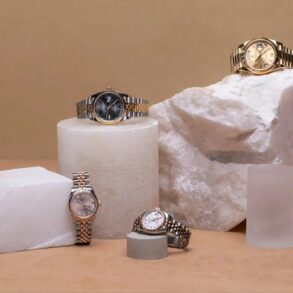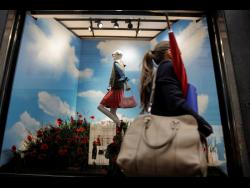When you think of investments, you probably imagine stock options, gold or perhaps even art.
But for a growing number of people, the smartest place to invest their money is in handbags made by the world’s most luxurious brands.
Not only do they carry your belongings, an It Bag can telegraph everything from your income to your taste and social status.
The most coveted items, the Chanel classic flap handbag and the Hermès Birkin, both start at around $15,000 — that’s if you can get your hands on one.
“It’s a commodity that is now a better investment than gold,” said Emily Abraham, chief executive of Love Luxury, a London company that authenticates and re-sells luxury handbags to wealthy buyers.
“The industry is booming.”
And even if it spends years dangling from your wrist, the value of certain bags can quickly double or triple from its original retail price.
Certain buyers are looking for second-hand Birkin bags that are weather-beaten and worn to project an aura of generational wealth.
The market for a Chanel bag is so stable that last year, Credit Suisse declared it one of the lowest volatility investments for luxury collectors.
Even though many countries are battling high inflation and increased housing costs, projections for the global luxury handbag market exceed a valuation of $53 billion by 2031, according to Transparency Market Research.
One driving factor behind the second-hand luxury bag market is scarcity: Fashion houses put tight controls on who can buy the bags and when.
“They are not something you can just walk into the store and get,” said Tanner Leatherstein, a Turkish artisanal leather worker.
Destroying a beautiful bag to assess its worth
Leatherstein has gained a huge following online by cutting up luxury bags to study their craftsmanship on his popular TikTok account.
With a practised hand, he tears luxury bags apart at the seams to examine up close their craftsmanship and the quality of the leather.
“It’s a little too plasticky for my taste”, he tells the camera in a video about the Louis Vuitton Félicie Pochette, a $2,200 bag he estimates cost less than a tenth of that to make.
Many high-end bags that retail for tens of thousands of dollars aren’t sold online or readily kept on display in boutiques.
Instead, a handful of customers are invited to buy them only once they have proven themselves in a series of unwritten tests that have become the subject of folklore.
“You have to play so many games,” Leatherstein said.
Those games might include proving loyalty by making repeated purchases in order to build a relationship with sales staff.
Influencers on TikTok, YouTube and Instagram dedicate entire video tutorials to the tricks you need to learn before you are invited to buy the bag.
“Just be open and genuine about who you are and what you want,” says YouTuber ziyistylebook in a video giving advice on shopping at Hermès.
Other influencers suggest a prospective buyer should not seem too eager, but must “dress the part” to appear worthy of the bag.
Fashionistas say it’s almost impossible to convince the sales associates at the Hermès Paris stores to sell you a Birkin, while those in the US casino town of Las Vegas are much more relaxed.
Loading YouTube content
Meanwhile, Chanel recently introduced a quota system limiting its customers to buying no more than two handbags every year.
It is this artificial scarcity that in part makes them such a status symbol for the wealthy (and the aspirationally wealthy) — and such a potent commodity for investors.
The rise of the superfake
The rise in luxury bags as investments has also given rise to a booming counterfeit market, some so well crafted that they are indistinguishable from the real thing.
What was once easy to pick for their cheap feel is now much harder thanks to skilled craftspeople and high quality materials.
Authenticating luxury bags, therefore, is a tricky business.
Luxury online marketplace The RealReal has been criticised for re-selling fakes marketed as genuine.
For each bag that comes through her doors, Emily Abraham from Love Luxury performs an exhaustive check for the tell-tale signs of a fake — odd stitching, a missing manufacturer’s certificate, something off about the lettering on the logo.
“I can spot them from a mile away,” she said.
“You do have to look a lot closer.”
Aside from the legal and ethical implications, the rise of superfakes also raises philosophical questions, chiefly: What makes a luxury bag ‘real’?
Shoppers may ask themselves what are luxury fashion houses selling that can’t be bought for a fraction of the price in an identical superfake?
“The bag’s material itself does not have innate value,” said Tanner Leatherstein.
“The value comes from the logo on it.”
Why a bag is a modern status symbol
If Abraham is satisfied a bag is real, she can pay sometimes double the bag’s retail price to a seller, often more if it’s “box fresh” and in good condition.
And they don’t even have to be practical to become a money spinner.
The Jacquemus Le Chiquito moyen, a bag so ludicrously tiny you can’t even fit a phone inside it, has started to appreciate in value on the resale market, according to Vogue.
Loading Instagram content
“The smaller the bag, the higher the value on the secondary market,” Abraham said.
Her buyers are typically the ultra wealthy, people who don’t want to jump through the hoops of buying luxury bags in store.
On TikTok, it can take only minutes for Tanner Leatherstein to slice through the stitching and reduce a Prada bag to a heap of scraps.
In the comments of his videos, fans delight in the absurdity of destroying something so coveted with so little hesitation.
“I don’t feel bad about it,” Leatherstein said with a smile.
“I don’t know what’s wrong with me.”
Loading Instagram content
For thousands of years, people have used their clothing and accessories to convey their social status and wealth.
So-called “quiet luxury” might be a buzzy term in 2023. But wearing expensive yet understated fabrics to look wealthy, but not gauche, dates back to Ancient Rome.
White lace ruffs adorned the necks of Elizabethan aristocrats.
The wider and more elaborate the ruff, the less likely it was that you needed to perform any practical task.
In the modern age, the vessel for your keys and your phone can say a lot about how you see yourself — and what you want others to believe about you.
“You buy these bags because of the social status, the implication of your accomplishment to the outside world,” said Leatherstein.
“You cannot go around, yelling, ‘hey, I’m rich. I’m so accomplished’. But if you carry a bag that’s worth $20,000 and everybody knows in your circle, that’s how you do it.”
This post was originally published on this site be sure to check out more of their content.




